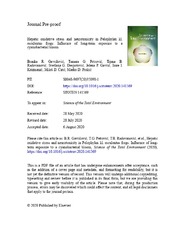| dc.creator | Gavrilović, Branka R. | |
| dc.creator | Petrović, Tamara G. | |
| dc.creator | Radovanović, Tijana B. | |
| dc.creator | Despotović, Svetlana G. | |
| dc.creator | Gavrić, Jelena P. | |
| dc.creator | Krizmanić, Imre I. | |
| dc.creator | Ćirić, Miloš | |
| dc.creator | Prokić, Marko D. | |
| dc.date.accessioned | 2020-09-18T14:46:04Z | |
| dc.date.available | 2022-08-12 | |
| dc.date.issued | 2021 | |
| dc.identifier.issn | 0048-9697 | |
| dc.identifier.uri | https://cer.ihtm.bg.ac.rs/handle/123456789/3677 | |
| dc.description.abstract | Although the long-term exposure of aquatic organisms to cyanobacterial blooms is a regular occurrence in the environment, the prooxidant and neurotoxic effects of such conditions are still insufficiently investigated in situ. We examined the temporal dynamics of the biochemical parameters in the liver of Pelophylax kl. esculentus frogs that inhabit the northern (N) side of Lake Ludaš (Serbia) with microcystins (MCs) produced in a cyanobacterial bloom over three summer months. The obtained data were compared with data on frogs that live on the southern (S), MC-free side of the same lake. Our results showed that the MC-producing bloom induced oxidative damage to proteins and lipids, observed as a decrease in the concentration of protein -SH groups and increased lipid peroxidation (LPO) in the liver of N frogs in comparison to S frogs. Glutathione (GSH) played a key role in the transient defense against the MC-induced development of LPO. The low glutathione peroxidase (GPx) activity detected in all groups of frogs from the N site was crucial for the observed prooxidant consequences. The bloom impaired cholinergic homeostasis as a result of a decrease in ChE activity. A delayed neurotoxic effect in relation to the prooxidant outcomes was observed. Our results also showed that even though the integrated biomarker response (IBR) of the antioxidant biomarkers increased during exposure, the individual biochemical parameters did not exhibit a well-defined time-dependent pattern because of specific adaptation dynamics and/or additional effects of the physicochemical parameters of the water. This comprehensive environmental ecotoxicological evaluation of the cyanobacterial bloom-induced biochemical alterations in the liver of frogs provides a new basis for further investigations of the prolonged, real-life ecotoxicity of the blooms. | en |
| dc.language.iso | en | sr |
| dc.publisher | Elsevier | sr |
| dc.relation | info:eu-repo/grantAgreement/MESTD/inst-2020/200007/RS// | sr |
| dc.rights | embargoedAccess | sr |
| dc.rights.uri | https://creativecommons.org/licenses/by-nc-nd/4.0/ | |
| dc.source | Science of the Total Environment | sr |
| dc.subject | Oxidative damage | sr |
| dc.subject | Antioxidant | sr |
| dc.subject | Biotransformation | sr |
| dc.subject | Cholinesterase | sr |
| dc.subject | Temporal dynamic | sr |
| dc.subject | Microcystin | sr |
| dc.title | Hepatic oxidative stress and neurotoxicity in Pelophylax kl. esculentus frogs: Influence of long-term exposure to a cyanobacterial bloom | en |
| dc.type | article | sr |
| dc.rights.license | BY-NC-ND | sr |
| dcterms.abstract | Кризманић, Имре И.; Петровић, Тамара Г.; Радовановић, Тијана Б.; Деспотовић, Светлана Г.; Гавриловић, Бранка Р.; Гаврић, Јелена П.; Ћирић, Милош; Прокић, Марко Д.; | |
| dc.rights.holder | Elsevier | sr |
| dc.citation.volume | 750 | |
| dc.citation.spage | 141569 | |
| dc.citation.rank | aM21~ | |
| dc.description.other | This is the peer reviewed version of the following article: Gavrilović BR, Petrović TG, Radovanović TB, Despotović SG, Gavrić JP, Krizmanić II, Ćirić MD, Prokić MD. Hepatic oxidative stress and neurotoxicity in Pelophylax kl. esculentus frogs: Influence of long-term exposure to a cyanobacterial bloom. Sci Total Environ. 2020;750:141569. [http://dx.doi.org/10.1016/j.scitotenv.2020.141569] | |
| dc.description.other | Published version:[http://cer.ihtm.bg.ac.rs/handle/123456789/3675] | |
| dc.identifier.pmid | 32853936 | |
| dc.identifier.doi | 10.1016/j.scitotenv.2020.141569 | |
| dc.identifier.fulltext | http://cer.ihtm.bg.ac.rs/bitstream/id/17338/j.scitotenv.2020.141569.pdf | |
| dc.identifier.scopus | 2-s2.0-85089696917 | |
| dc.identifier.wos | 000585694600057 | |
| dc.type.version | acceptedVersion | sr |


